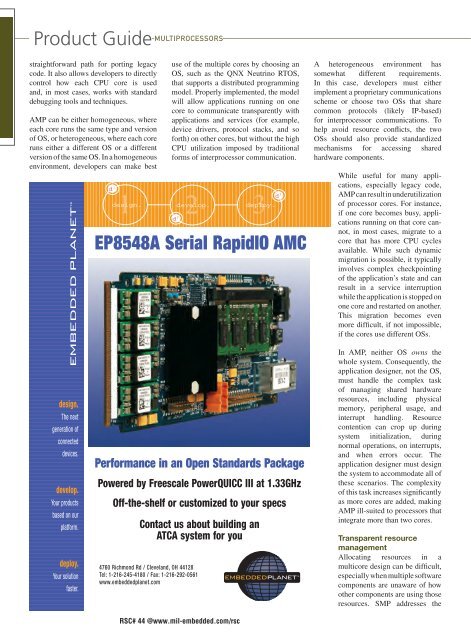Military Embedded Systems Summer 2006
Military Embedded Systems Summer 2006
Military Embedded Systems Summer 2006
Create successful ePaper yourself
Turn your PDF publications into a flip-book with our unique Google optimized e-Paper software.
Product Guide<br />
multiprocessors<br />
straightforward path for porting legacy<br />
code. It also allows developers to directly<br />
control how each CPU core is used<br />
and, in most cases, works with standard<br />
debugging tools and techniques.<br />
AMP can be either homogeneous, where<br />
each core runs the same type and version<br />
of OS, or heterogeneous, where each core<br />
runs either a different OS or a different<br />
version of the same OS. In a homogeneous<br />
environment, developers can make best<br />
use of the multiple cores by choosing an<br />
OS, such as the QNX Neutrino RTOS,<br />
that supports a distributed programming<br />
model. Properly implemented, the model<br />
will allow applications running on one<br />
core to communicate transparently with<br />
applications and services (for example,<br />
device drivers, protocol stacks, and so<br />
forth) on other cores, but without the high<br />
CPU utilization imposed by traditional<br />
forms of interprocessor communication.<br />
1 2 3<br />
d 1 d 3<br />
design. develop. deploy.<br />
d 2<br />
EP8548A Serial RapidIO AMC<br />
A heterogeneous environment has<br />
somewhat different requirements.<br />
In this case, developers must either<br />
implement a proprietary communications<br />
scheme or choose two OSs that share<br />
common protocols (likely IP-based)<br />
for interprocessor communications. To<br />
help avoid resource conflicts, the two<br />
OSs should also provide standardized<br />
mechanisms for accessing shared<br />
hardware components.<br />
While useful for many applications,<br />
especially legacy code,<br />
AMP can result in underutilization<br />
of processor cores. For instance,<br />
if one core becomes busy, applications<br />
running on that core cannot,<br />
in most cases, migrate to a<br />
core that has more CPU cycles<br />
available. While such dynamic<br />
migration is possible, it typically<br />
involves complex checkpointing<br />
of the application’s state and can<br />
result in a service interruption<br />
while the application is stopped on<br />
one core and restarted on another.<br />
This migration becomes even<br />
more difficult, if not impossible,<br />
if the cores use different OSs.<br />
design.<br />
The next<br />
generation of<br />
connected<br />
devices.<br />
develop.<br />
Your products<br />
based on our<br />
platform.<br />
deploy.<br />
Your solution<br />
faster.<br />
Performance in an Open Standards Package<br />
Powered by Freescale PowerQUICC III at 1.33GHz<br />
Off-the-shelf or customized to your specs<br />
Contact us about building an<br />
ATCA system for you<br />
4760 Richmond Rd / Cleveland, OH 44128<br />
Tel: 1-216-245-4180 / Fax: 1-216-292-0561<br />
www.embeddedplanet.com<br />
RSC# 44 @www.mil-embedded.com/rsc<br />
In AMP, neither OS owns the<br />
whole system. Consequently, the<br />
application designer, not the OS,<br />
must handle the complex task<br />
of managing shared hardware<br />
resources, including physical<br />
memory, peripheral usage, and<br />
interrupt handling. Resource<br />
contention can crop up during<br />
system initialization, during<br />
normal operations, on interrupts,<br />
and when errors occur. The<br />
application designer must design<br />
the system to accommodate all of<br />
these scenarios. The complexity<br />
of this task increases significantly<br />
as more cores are added, making<br />
AMP ill-suited to processors that<br />
integrate more than two cores.<br />
Transparent resource<br />
management<br />
Allocating resources in a<br />
multicore design can be difficult,<br />
especially when multiple software<br />
components are unaware of how<br />
other components are using those<br />
resources. SMP addresses the
















